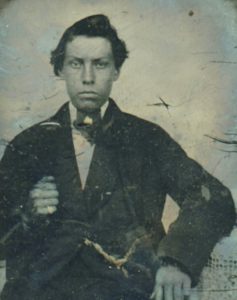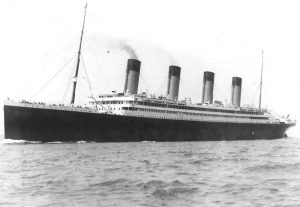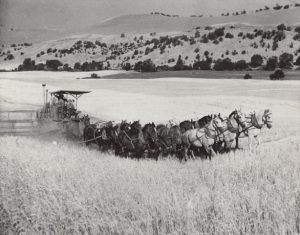 A few years ago, as I was looking into what NEHGS’ collection held on Italian research subjects, I came across a manuscript that was created in 1954 by a woman who was interested in documenting the Italians of Kingston, Massachusetts. The Coming of Italians to Kingston by Esther DiMarzo was digitized and is available on our web site. It covers those who first appeared in records in Kingston from about 1899 to 1912. Esther primarily relied on tax lists and vital records and, when possible, included a few stories and information from descendants who were still in Kingston at the time of her compilation. Continue reading From Cento to America
A few years ago, as I was looking into what NEHGS’ collection held on Italian research subjects, I came across a manuscript that was created in 1954 by a woman who was interested in documenting the Italians of Kingston, Massachusetts. The Coming of Italians to Kingston by Esther DiMarzo was digitized and is available on our web site. It covers those who first appeared in records in Kingston from about 1899 to 1912. Esther primarily relied on tax lists and vital records and, when possible, included a few stories and information from descendants who were still in Kingston at the time of her compilation. Continue reading From Cento to America
Category Archives: Family Stories
Tell me no lies

While researching family stories for verification (and, let’s face it, amusement), I began to think that we all face the same questions: “Huh?” turns into “Why did he/she/they do that?,” which morphs into “What?!,” which then becomes “What were they thinking?!?!” We look for the truth but often find muddled facts, conflicting stories, and outright prevarications.
I discovered with the help of a maternal cousin that one of our ancestors, Shadrack Ireland (1718–1780), was something of a rogue/cad/religious nut. Sure enough, when I read about his life, history knows him as a pipe maker, carpenter, and “religious leader” who espoused Perfectionism at the time of The Great Awakening, a Christian revival in the 1730s and ‘40s. Continue reading Tell me no lies
The widow of St. Casimir

My sister-in-law Sue and I hoped we might uncover a backstory behind the marriage of her great-great-grandparents. Aimé Vallée, age 21, of St. Casimir, Québec, wed his third cousin, Marguerite Vallée, age 43, widow of François Trottier, mother of twelve children. François died in November 1844, age 69; Marguerite married Aimé three months later, with a dispensation omitting two additional banns of marriage. We sensed our curiosity might be allayed by visiting St. Casimir, midway between Trois Rivières and Québec City. Its splendid late nineteenth-century Catholic church attests to its central place in the life of that community and a long tradition of recording genealogy. Continue reading The widow of St. Casimir
Tired of waiting

Immigration to the United States has often been a difficult and time-consuming process, and never more so than during the first half of the twentieth century. The immigration laws of the 1920s established a quota system whereby only 2% of the national population of each country could immigrate annually; in effect, this meant that if there were 2 million Germans in the United States, then only 40,000 Germans could come to the United States each year. Continue reading Tired of waiting
Great fires

In my last Vita Brevis post, I mentioned that an enormous wild fire had swept through the area where my maternal grandmother’s family has farmed for more than a century. A distant cousin told me, “The fire is total devastation for many: the total loss of this year’s crop, homes, combines, and equipment. For us it could have been much worse. We lost no equipment or buildings, only about 500 acres of wheat.” A tragic loss of the best crop folks could remember in many, many years. Continue reading Great fires
A pirate’s life

A year or so back, I was contacted by a favorite cousin of mine asking for help with questions his nephew had regarding our family tree. His nephew, a serious-minded young man (and a very typical teenager), was curious about any infamous or otherwise notable kin among our branches. And, since I’ve managed to somehow insinuate myself as the family’s alleged expert on such things, well, I guess I’d become their “go-to” guy for an answer or two. (I know, hard to believe, right?) I should mention that the young man who would be asking any of these questions was only thirteen years old! Continue reading A pirate’s life
‘A source of pleasure and profit’

61 Bowdoin Street, Boston, Sunday, 12 November 1865: Frank & Sam are both ailing and both studying too hard. We try to hold them back and they declare they are not hurting themselves – both look poorly though. Regie keeps pretty well – and is improving in Latin & French wonderfully but is behind hand in Arithmetic. Morris too improves in every way – especially in Writing. They are all bright enough, if only their health hold out. Continue reading ‘A source of pleasure and profit’
Living moments
Many of us cherish the notion that historical photographs capture a frozen moment in time. Upon more detailed examination, though, studio pictures sometimes possess more artifice and contrivance than would have been expected. Take, for instance, these paired images of my great-great-great-grandparents, Reuben Paine and Lovicy Hall. Continue reading Living moments
Contributing citizens
 Several years ago my mother gave me a family picture that is unlike most family pictures; in fact, without the identifying information on the back, it doesn’t seem to be a family picture at all. Thank goodness for the label, which gives a ton of information, not only about the location, date, and people, but also about farming practices at the time. Continue reading Contributing citizens
Several years ago my mother gave me a family picture that is unlike most family pictures; in fact, without the identifying information on the back, it doesn’t seem to be a family picture at all. Thank goodness for the label, which gives a ton of information, not only about the location, date, and people, but also about farming practices at the time. Continue reading Contributing citizens
Lost to history

I recently read a book by Ellen Marie Wiseman entitled What She Left Behind. Among other themes in the book, it depicted the treatment of a woman who was committed to an asylum in early 1920 by her father. The main character was committed because she reacted strongly to a marriage arranged by her parents; she displayed outbursts of emotion. The author of What She Left Behind describes the conditions in an asylum based on the Willard Asylum in Ovid, New York, during the early twentieth century. Often, when I’m reading fiction, I think about my family tree and those living during the years in which the novel takes place. Were there individuals in my own family tree who “went mad” or were sent to live in an asylum? Were these episodes recognized as depression or mental illness; or was a person abandoned, without family to care for them and, thus, committed? Continue reading Lost to history

